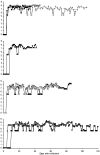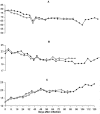Trypanosoma brucei rhodesiense transmitted by a single tsetse fly bite in vervet monkeys as a model of human African trypanosomiasis
- PMID: 18846231
- PMCID: PMC2565695
- DOI: 10.1371/journal.pntd.0000238
Trypanosoma brucei rhodesiense transmitted by a single tsetse fly bite in vervet monkeys as a model of human African trypanosomiasis
Abstract
We have investigated the pathogenicity of tsetse (Glossina pallidipes)-transmitted cloned strains of Trypanosoma brucei rhodesiense in vervet monkeys. Tsetse flies were confirmed to have mature trypanosome infections by xenodiagnosis, after which nine monkeys were infected via the bite of a single infected fly. Chancres developed in five of the nine (55.6%) monkeys within 4 to 8 days post infection (dpi). All nine individuals were successfully infected, with a median pre-patent period of 4 (range = 4-10) days, indicating that trypanosomes migrated from the site of fly bite to the systemic circulation rapidly and independently of the development of the chancre. The time lag to detection of parasites in cerebrospinal fluid (CSF) was a median 16 (range = 8-40) days, marking the onset of central nervous system (CNS, late) stage disease. Subsequently, CSF white cell numbers increased above the pre-infection median count of 2 (range = 0-9) cells/microl, with a positive linear association between their numbers and that of CSF trypanosomes. Haematological changes showed that the monkeys experienced an early microcytic-hypochromic anaemia and severe progressive thrombocytopaenia. Despite a 3-fold increase in granulocyte numbers by 4 dpi, leucopaenia occurred early (8 dpi) in the monkey infection, determined mainly by reductions in lymphocyte numbers. Terminally, leucocytosis was observed in three of nine (33%) individuals. The duration of infection was a median of 68 (range = 22-120) days. Strain and individual differences were observed in the severity of the clinical and clinical pathology findings, with two strains (KETRI 3741 and 3801) producing a more acute disease than the other two (KETRI 3804 and 3928). The study shows that the fly-transmitted model accurately mimics the human disease and is therefore a suitable gateway to understanding human African trypanosomiasis (HAT; sleeping sickness).
Conflict of interest statement
The authors have declared that no competing interests exist.
Figures




References
-
- Jennings FW, Whitelaw DD, Urquhart GM. The relationship between duration of infection with Trypanosoma brucei in mice and the efficacy of chemotherapy. J Parasitol. 1977;75:143–153. - PubMed
-
- Baker JR, Taylor ER. Experimental infections of the Chimpanzee (Pan Troglodytes) with Trypanosoma brucei brucei and Trypanosoma brucei rhodesiense. Ann Trop Med Parasitol. 1971;65:471–485. - PubMed
-
- Schmidt H, Sayer P. T. b. rhodesiense infection in vervet monkeys. II. Provocation of the encephalitic late phase by treatment of infected monkeys. Tropenmed Parasitol. 1982;33:255–259. - PubMed
-
- Bouteille B, Millet P, Enanga B, Mezui MJ, Keita M, Jauberteau MO, Georges A, Dumas M. Human African trypanosomiasis: contributions of experimental models. Bull Soc Pathol Exot. 1998;91:127–132. - PubMed
Publication types
MeSH terms
Grants and funding
LinkOut - more resources
Full Text Sources
Medical

